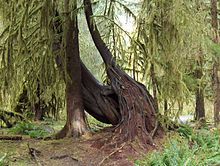Hoh (people)
The Hoh are an American Indian tribe living in Washington State . They live in the northwest of the Olympic Peninsula . According to the 2000 census, there were 102 people on the reservation, 81 of whom were considered Native Americans , that is, registered Native Americans.
Originally the Hoh spoke the language of the Quileute , the Chimakum , as their sub-tribe ( band ) they were long considered. Like most tribes in the northwest, the Hoh lived mostly on salmon .
history

For 1780 the number of Quileute and Hoh together is estimated to be about 500. The Hoh were linked with the Quinault and the Quileute in a confederation. According to oral tradition, it controlled the area between the Makah in the northwest and Grays Harbor in the south. Together with the Queet , the Hoh were responsible for the central section of the coast to repel attacks and protect the hunting areas - such as against the Klallam . When the merchant Charles Barkley landed on the Hoh River in July 1787 to trade with the local Indians, there were disputes in the course of which the team was gutted. In 1808 the Hoh came into conflict again with intruders, who took them prisoner and sold or bartered them as slaves. They were Russian traders and Unangan who came from the Aleutian Islands . They were triggered by an American merchant ship in May 1811.
The treaty with the USA (1855/59)
The Hoh lost their tribal territory after the Quinault River Treaty was signed on July 1, 1855. Washington Territory Governor Isaac Stevens signed the treaty on January 25, 1856, and ratified it on March 8, 1859 by Congress .
Fight for land rights and compensation
By decree (executive order) of September 11, 1893, the Hoh received a 443 acre reserve. In 1905 there were only 62 Hoh. The decline, which can no longer be precisely determined, was primarily due to illness and assimilation into the rest of society.
In 1911, Congress asked the government in Washington's capital, Olympia , not to privatize and reallocate land in the small Hoh Reservation, but in the much larger Quileute. But as early as 1913, the settlement campaign had to be broken off due to a lack of arable and pasture land.
The area of the reserve was cleared in 1954.
With the Washington State Indian Jurisdiction Act in 1963, the state government took control of various social programs. That same year, accused the four strains of the Hoh River Treaty for compensation for the ceded land, because they had so far together only about 25,000 dollars received. This involved areas with a total area of 688,000 acres . The deadline was March 8, 1858. The Hoh- and Quileute received $ 112,152.60, which should be distributed according to the number of members of the tribes.
Self-government
After the tribe recognized the Indian Reorganization Act of 1934, it was in a long limbo that did not end until May 24, 1969 with the adoption of a constitution. The Hoh Tribal Business Committee , whose members are elected every two years, is the governing body.
In the 1970s, around 15 to 20 people lived on the reservation. The tribe has set up a tribal government and ensures a constantly updated role in which the tribesmen are recorded. In 1985 the tribe had 91 members.
Current situation
The Hoh now live in the tiny Hoh Indian Reservation , which covers only 1.929 km² and is located at the mouth of the Hoh River , directly on the Pacific coast of Jefferson County . The coastline is about 1.5 km long. In 2007, 86 of the 147 registered Hoh were permanently resident in the reserve.
Most of the tribesmen make a living from fishing, but basketry and carving also play a certain role, including the manufacture of canoes. Two of the Hoh still mastered this art in the 1980s, and they passed on their knowledge. In addition, there is seafood picked up from the beach or caught in nets. The forests that were cut down in 1954 have recovered over the last half century, so that some Hoh are now back in work in a small timber industry.
Once a day, a doctor, a dentist and a nurse visit the infirmary in Queets or the Roger Saux Health Center in Taholah . Students study in forks . Most of the Hoh are Protestants, some are from the Indian Shaker Church .
Vivian Lee is the chairperson .
literature
- Robert H. Ruby / John A. Brown: A Guide to the Indian Tribes of the Pacific Northwest , University of Oklahoma Press 1992, pp. 81-83
See also
- First Nations history
- United States Indian Policy
- History of Washington
- List of Indian tribes recognized in Canada
Remarks
- ↑ According to the US Census Bureau: [1] .
- ↑ Cf. Treaty with the Quinault ( Memento of the original from October 19, 2008 in the Internet Archive ) Info: The archive link was inserted automatically and has not yet been checked. Please check the original and archive link according to the instructions and then remove this notice.
- ^ Cf. An act to provide for allotments to certain members of the Hoh, Quileute, and Ozette Tribes of Indians in the State of Washington .


